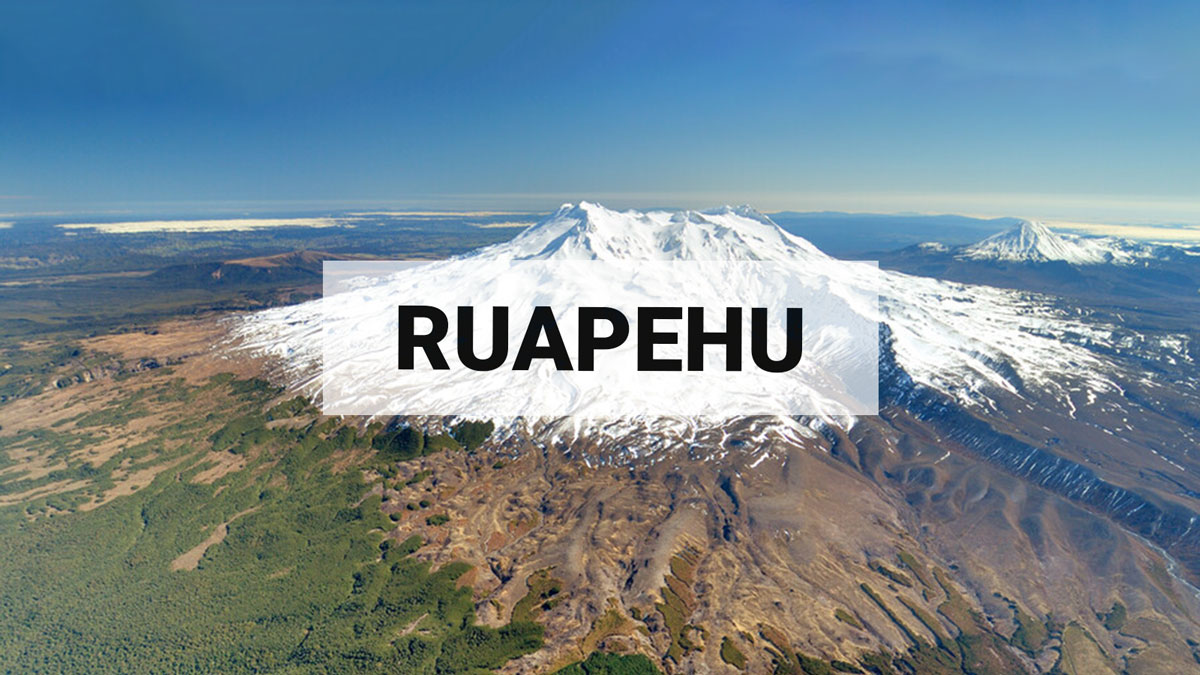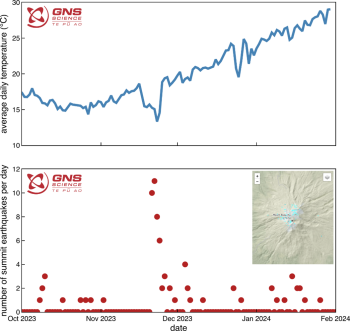
Te Wai ā-moe (Crater Lake) enters new heating episode at Mt Ruapehu. Volcanic activity remains low, and the Volcanic Alert Level remains at Level 1.
Te Wai ā-moe (Ruapehu Crater Lake) has entered a new heating episode, currently being 29 °C. Other volcanic monitoring indicators remain within normal ranges. Volcanic activity remains low. The Volcanic Alert Level remains at Level 1 and the Aviation Colour Code at Green.
Since mid-October 2023, the temperature of Te Wai ā-moe (Crater Lake) has been slowly increasing (Fig. 1), now reaching 29 ºC marking a new heating episode is under way. The rise has occasionally been impacted by some of the summer rainfall (seen as short, sharp drops in temperature). The heat flow into the lake is currently around 280 MW, typical of when the lake is heating.
Figure 1: Plot of Te Wai ā-moe (Crater Lake) temperature (top) and number of summit earthquakes per day (bottom – see inset for location) over time.
This new heating episode is accompanied by monitoring trends typically associated with crater lake heating at Mt Ruapehu. Over the last few weeks, the lake colour has changed from a blue green tinge seen when the lake is cooler, to the more common grey colour seen when warm. Minor upwellings are present in the lake and sulphur slicks are present on the lake surface. The lake is overflowing, typical during the summer melt.
The seismic monitoring equipment at Mt Ruapehu has recorded a sequence of small earthquakes at 3-8 km depth clustered under the volcano since late November (Fig. 1). Earthquake size has ranged from M0.3 to M2.4. The level of volcanic tremor has remained weak during the start of this new heating episode.
The scanDOAS gas scanning equipment and gas flights have measured moderate levels of SO2 (sulphur dioxide) gas output as the lake has heated.
The recent earthquakes at moderate depth under the volcano may be in response to a volcanic process like the injection of new magma at depth under the volcano. However, the other monitoring parameters like volcanic tremor, heat flow, gas flow, and lake surface behaviour are all typical of a heating episode in the crater lake, which is being driven by shallower processes. Data observed to date is typical of the past process’s seen in the active hydrothermal system associated with the crater lake.
The change in lake colour is consistent with more gas flow disturbing sediment at the base of the lake, which is now suspended in the lake water. This indicates the vents at the bottom of the lake are at least partially open, allowing hot gas and steam to drive the increase in lake temperature. Volcanic tremor, a key indicator of volcanic fluid movement, remains low and other monitoring indicators are within normal ranges.
Overall, this is consistent with a low level of volcanic activity usually seen during a heating episode. As a result, the Volcanic Alert Level remains at Level 1. The Aviation Colour Code remains Green.
Mt Ruapehu is an active volcano and has the potential to erupt with little or no warning when in a state of minor volcanic unrest.
The Volcanic Alert Level reflects the current level of volcanic unrest. The Volcanic Alert Level should not be used to forecast future activity.
Volcanic Alert Level 1 indicates the primary hazards are those expected during volcanic unrest: steam discharge, volcanic gas, earthquakes, landslides, and hydrothermal activity. While Volcanic Alert Level 1 is mostly associated with environmental hazards, potential for eruption hazards also exists and eruptions can still occur with little or no warning. Volcanic Alert Levels 3, 4 and 5 are reserved for eruptions with varying impact distances.
For information on access to the Mt Ruapehu area, please visit the Department of Conservation’s website on volcanic risk in Tongariro National Park and follow the DOC Tongariro Facebook page for further updates.
For information about responding to volcanic activity there are guidelines from the National Emergency Management Agency.
https://getready.govt.nz/emergency/volcanic-activity/
GNS Science and its National Geohazards Monitoring Centre continue to closely monitor Mt Ruapehu for further changes.
Ery Hughes (she/her) Duty Volcanologist Media Contact: 021 574 541 or media@gns.cri.nz

